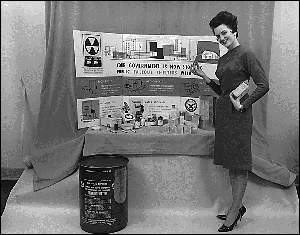The Graceland of Cold War Tourism: The Greenbrier Bunker
The Graceland of Cold War Tourism: The Greenbrier Bunker
“All wars end in tourism,” writes Tom Vanderbilt—even the Cold War. Thus we can visit the Nevada Test Site, the Titan Missile Museum, and the fallout shelter exhibit at the Smithsonian. The most extravagant of all U.S. Cold War tourist sites, and the most expensive to visit ($30), is the Greenbrier Bunker, underneath the legendary Greenbrier Resort in White Sulphur Springs, West Virginia. 
Here, a five-hour drive southwest of Washington, D.C., behind a blast door that weighs 25 tons, all 100 senators and 435 representatives were supposed to take refuge during a nuclear attack. Here they could live for sixty days, continuing the work of governing the country: debating the issues, passing laws, somehow communicating with the executive branch sequestered elsewhere, and addressing the public—or whatever was left of the public. And here, the public can see how the government prepared to preserve representative democracy after a nuclear war.
The tour is hugely popular, attracting 33,000 people in 2007, according to the longtime manager of bunker tours, Linda Walls. At the start, visitors learn a little history: construction of the bunker was begun by the Eisenhower administration in 1957 and completed just in time for the Cuban Missile Crisis in 1962. It remained a military secret until 1992, when Ted Gup revealed its existence and location in a Washington Post article. The hotel started offering a tour in 1995 for its guests, and was opened to the general public in 2006. The lesson visitors are supposed to take home from the tour has two parts: the Greenbrier Bunker demonstrates the conservatives’ belief that the United States could survive a nuclear war; and it also conveys the message that our leaders were committed, even after a nuclear war, to keep representative democracy functioning. (The Bunker is now part of the Greenbrier Hotel, which operates the tours.)
On the tour, however, some skeptics speak out. One of them is Bill Geerhart, editor and co-founder of conelrad.com, a website devoted to Cold War popular culture. It was he who coined the phrase “Graceland of Atomic Tourism.”
You start at the first blast door—twelve feet high, ten feet wide, and eighteen inches thick. It may look like the door to a bank vault, but unlike a bank vault, it can be opened and closed only from the inside. When all three blast doors were closed and locked, the guide explains, the people inside were sealed off from the outside world, with enough air for seventy-two hours. After that, vents would be opened and outside air circulated, after being filtered for nuclear, chemical, and biological agents.
THE FIRST stop for the tour (and also for congresspeople arriving after a nuclear attack) is the decontamination area. It’s a narrow blue-tiled room with high-pressure shower heads at two levels and tight doors...
Subscribe now to read the full article
Online OnlyFor just $19.95 a year, get access to new issues and decades' worth of archives on our site.
|
Print + OnlineFor $35 a year, get new issues delivered to your door and access to our full online archives.
|






